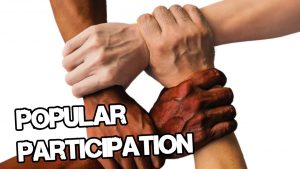How to promote popular participation: Popular Participation is a term used to denote a situation where a majority of citizens in a country are interested and involved in the affairs of the state and decision making, especially as it affects them.
Popular Participation ensures that at the end of the day, it is the will of majority of the citizens that prevails in the state. It gives an opportunity to everyone to contribute their quota, and express their views as to how the state is run.
Relevance of public opinion and inclusive government are core features of a state where popular place is practiced. Not only are the citizens willing to give their input towards to the development of their society, the government is also willing to include them in the affairs of the state and even actively seeking their contribution.

Recommended: Differences between military and democratic rule
There are several ways through which popular participation is expressed or reflected. They include;
1. Voting: Since the bulk popular participation is rooted in political activities, voting is a major way of expressing individual interest in the affairs of the state. When citizens come out to vote, it shows that they are interested in selecting quality leaders to represent them in the government.

2. Political education: Education about the affairs of the state and government can be given to and inculcated in the citizens in many ways. It can be done through socialisation, starting with the children within the family circle. When discussions about the government, how to be law-abiding and the right attitude of citizenry is held in homes, it is a valid form of political awareness for the members of that family. Political education in form of teaching students their civic rights and obligations in schools, and for the rest of the population, seminars, conferences and rallies are often held in that regard.
3. Co-operative Societies: These are the associations of people with a collective interest in a trade, profession or ideology. These are also the pressure groups. Their role is influence government decisions for the good of their members and inevitably, the whole populace.
Also see: Impact of colonialism in Africa
4. Campaigning: When citizens come out in their numbers to offer their support and campaign for their choice candidate, it shows a dedication to the political process. It also shows that they have pondered on the affairs of the country enough to decide who they think would best occupy leadership positions in the government.

5. Group Action: These includes peaceful strikes, demonstrations and protests by the people against policies of government that are unfavorable or detrimental to public welfare or collective interest. The activities of political parties can also be classified as group action, as it is a movements of people with similar political interests, with an aim to take over government by electoral processes.
6. Public opinion and Government consultation: Opinion polls, referendums, call for public suggestions for constitutional amendment are several ways through which the government actively interact with the governed for the interest of all. Also, dialogue with aggrieved or marginalised groups, or sometimes the minority groups, on how to better look into their welfare is a form of popular participation.
Also see: Why Lawyer Put On Wigs in Court
7. Government Accessibility: When the government is inaccessible to the people they rule, it defeats the purpose of democracy and makes popular participation difficult to achieve. Certain government documents and books should be made available for the general public to consult and refer to. An ombudsman department where citizens go to make their complaints about government institutions will also help the leaders know how the people feel about their policies and way of governance.

Recommended: Differences between parliamentary and presidential system of government
Challenges of Popular Participation
Despite the fact that popular participation is a welcome inclusion in the way our democracies run, it is not void of challenges itself. It is often viewed as unrealistic and unachievable in these times because of several barriers. Some of these barriers include;
1. Cost: For countries still struggling to keep their head above water or who are in debt, funding popular participation can become an unnecessary expenditure rather than a welcome policy. The awareness and sensitisation programmes often cost a lot time and money, and so do opinion polls and referendums and other programmes that facilitate popular participation.
2. Knowledge Divide: Involving the people in the decision making process of the country may be easier said than done due to the knowledge divide between the people and the government. Some technical terms and complex decisions that are used and made in the daily business of governance may be too complex for the average citizen to comprehend, let alone contribute.
Also see: How to become a successful lawyer: 7 qualities you will need
3. Financial Divide: What may be obtainable in many places where popular participation is practiced is the involvement of the wealthy in the decision making process to the exclusion of the poorer population. This does not reflect the true spirit of democracy and defeats the purpose of democracy, since only a select few are involved in the participatory process.
4. Expections Divide: Those in the business of governance truly understand what it takes to make decisions affecting a country or organisation; from the smallest to the most critical. However, citizens often have this unrealistic expectation when it comes to implementation of decisions made. They expect a quick result, even when the decision would clearly need time to become visible.
Also see: Top 10 Law Firms in the World 2021
Ways of promoting popular participation
The ways of promoting popular participation include;
1. Mobilisation of Community groups and associations: General awareness and sensitisation often scratches the surface alone, and the information fails to trickle down to the people in the grassroots. The narrative would be different if community group leaders are involved in the education process. If they are empowered with the information and appropriate tools to disseminate it, they would have no qualms delivering it to the people in the way they would understand it and be willing to take action.
Also see: Top Signs to know an intelligent person
2. The use of Social Media: The internet has made so many things easy in the present day, and prevalent among these things is communication.

Communication is also the most efficient way to share the workings of popular participation and cultivate the people’s interest in it. Since social media makes these things a whole lot easier, and a lot of people are using it, it would have more far-reaching effects. Here, it can be employed to make the people aware of popular participation and properly educate them about their rights and obligations.
Must read: Importance of the technology in education today
3. Advertisement using powerful marketing strategies: Certain marketing and advertisement tools are designed to catch the attention of a lot of people at a time, and embed itself in their subconscious. Such marketing tools can be harnessed by professionals in informing and convincing the people to become active participants and supporters of popular participation.
4. Providing Incentives: Providing incentives can be a great way to motivate and encourage the people to participate actively in the affairs of their country.
Things like organising competitions to that effect, in schools and colleges and offering cash or other prizes to winners; reward for the most active in community service geared towards promoting popular participation, etc. These are but a few ways through which we can motivate people to act accordingly.
There is a constant stream of information through our various media outlets, and there is also a constant consumption of this information by people. The government and concerned citizens should take advantage of this and use these outletsto make people aware of popular participation.
In conclusion, I recommend that you watch the YouTube video below for more information on how to promote popular participation in politics. Trust me, you will learn a lot by watching.

Edeh Samuel Chukwuemeka, ACMC, is a lawyer and a certified mediator/conciliator in Nigeria. He is also a developer with knowledge in various programming languages. Samuel is determined to leverage his skills in technology, SEO, and legal practice to revolutionize the legal profession worldwide by creating web and mobile applications that simplify legal research. Sam is also passionate about educating and providing valuable information to people.
Very interesting webs for learning